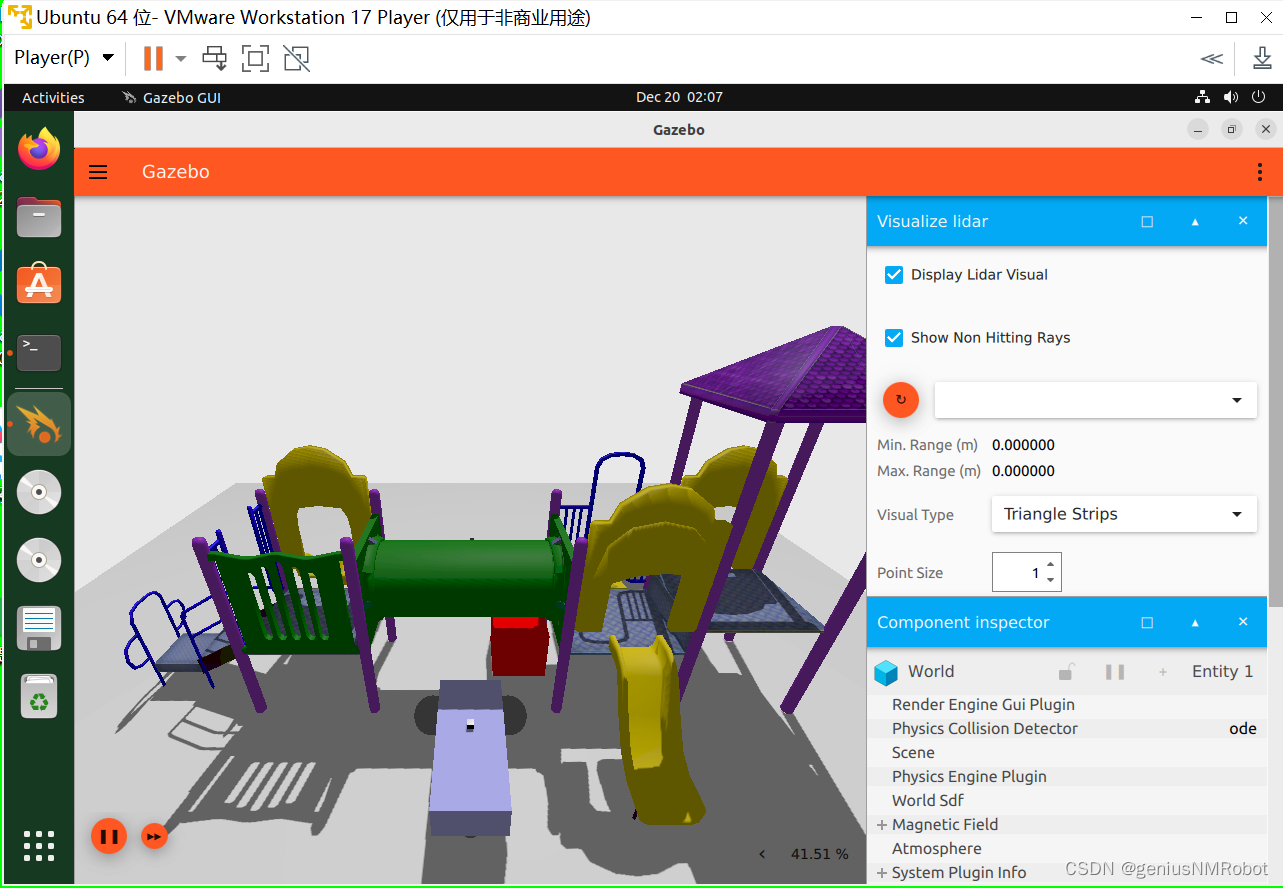ros2机器人在gazebo中移动方案
原文连接Gazebo - Docs: Moving the robot (gazebosim.org)
很重要的地方:使用虚拟机运行Ubuntu的时候,需要关闭”加速3D图形“的那个选项,否则gazebo无法正常显示。
Moving the robot(使用命令移动机器人示例)
In this tutorial we will learn how to move our robot. We will use the robot we built in the?Build your own robot?tutorial. You can download the robot from?here. You can also find the finished world of this tutorial?here.
What is a plugin
To make our robot move we will use the?diff_drive?plugin. But before doing so let's answer the question "What is a plugin?" A plugin is a chunk of code that is compiled as a shared library and inserted into the simulation. Plugins make us control many aspects of the simulation like world, models, etc.
Diff_drive plugin
diff_drive?plugin helps us control our robot, specifically a robot that can be differentially driven. Let's setup the plugin on our robot. Open the?building_robot.sdf?and add the following code within the?vehicle_blue?model tags.
<plugin
filename="gz-sim-diff-drive-system"
name="gz::sim::systems::DiffDrive">
<left_joint>left_wheel_joint</left_joint>
<right_joint>right_wheel_joint</right_joint>
<wheel_separation>1.2</wheel_separation>
<wheel_radius>0.4</wheel_radius>
<odom_publish_frequency>1</odom_publish_frequency>
<topic>cmd_vel</topic>
</plugin>The?<plugin>?tag has two attributes,?filename?which takes the library file name and?name?which takes the name of the plugin. In the?<left_joint>?and?<right_joint>?tags we define the joints which connect the left and the right wheel with the body of the robot, in our case?left_wheel_joint?and?right_wheel_joint.?<wheel_separation>?takes the distance between the two wheels. Our robot has its?left_wheel?at 0.6 m and the?right_wheel?at -0.6 m in y-axis with respect to the?chassis, so the?wheel_separation?is 1.2 m.?<wheel_radius>?takes the radius of the wheel which was defined in the?<radius>?tag under the wheel link.?<odom_publish_frequency>?sets the frequency at which the odometry is published at?/model/vehicle_blue/odometry.?cmd_vel?is the input?<topic>?to the?DiffDrive?plugin.
Topics and Messages
Now our model is ready. We just need to send commands (messages) to it. These messages will be published (sent) on the?cmd_vel?topic defined above.
A topic is simply a name for grouping a specific set of messages or a particular service. Our model will subscribe (listen) to the messages sent on the?cmd_vel?topic.
Launch the robot world:
gz sim building_robot.sdf
In another terminal let's send a message to to our robot:
gz topic -t "/cmd_vel" -m gz.msgs.Twist -p "linear: {x: 0.5}, angular: {z: 0.05}"
Now you should have your robot moving in the simulation.
Note:?Don't forget to press the play button in the simulation.
The command specifies the topic to publish to after the?-t?option. After the?-m?we specify the message type. Our robot expects messages of type?Twist?which consists of two components,?linear?and?angular. After the?-p?option we specify the content (value) of the message: linear speed?x: 0.5?and angular speed?z: 0.05.
Hint:?You can know what every topic option does using this command:?gz topic -h
For more information about?Topics?and?Messages?in Gazebo check the?Transport library tutorials
Moving the robot using the keyboard(使用按键遥控机器人示例)
Instead of sending messages from the terminal we will send messages using the keyboard keys. To do so we will add two new plugins:?KeyPublisher?and?TriggeredPublisher.
KeyPublisher
KeyPublisher?is an?gz-gui?plugin that reads the keyboard's keystrokes and sends them on a default topic?/keyboard/keypress. Let's try this plugin as follows:
-
In one terminal type
gz sim building_robot.sdf -
In the top right corner click on the plugins dropdown list (vertical ellipsis), click the Key Publisher.
-
In another terminal type
gz topic -e -t /keyboard/keypress
The last command will display all messages sent on?/keyboard/keypress?topic.
In the Gazebo window press different keys and you should see data (numbers) on the terminal where you run the?gz topic -e -t /keyboard/keypress?command.

We want to map these keystrokes into messages of type?Twist?and publish them to the?/cmd_vel?topic which our model listens to. The?TriggeredPublisher?plugin will do this.
Triggered Publisher
The?TriggeredPublisher?plugin publishes a user specified message on an output topic in response to an input message that matches user specified criteria. Let's add the following code under the?<world>?tag:
<!-- Moving Forward-->
<plugin filename="gz-sim-triggered-publisher-system"
name="gz::sim::systems::TriggeredPublisher">
<input type="gz.msgs.Int32" topic="/keyboard/keypress">
<match field="data">16777235</match>
</input>
<output type="gz.msgs.Twist" topic="/cmd_vel">
linear: {x: 0.5}, angular: {z: 0.0}
</output>
</plugin>This code defines the?triggered-publisher?plugin. It accepts messages of type?gz.msgs.Int32?on the?/keyboard/keypress?topic and if the value in the?data?field matches?16777235(Up arrow key) it outputs a?Twist?message on the?cmd_vel?topic with values?x: 0.5,?z: 0.0.
Now launch?building_robot.sdf?then add the Key Publisher plugin and our robot should move forward as we press the Up arrow key ↑ (make sure you start the simulation by pressing the play button to see the robot move forward after pressing the Up arrow key).
There is a demo explaining how the?Triggered Publisher?works.
Moving using arrow keys
To see what values are sent on the?/keyboard/keypress?topic when pressing the arrows we can use the?--echo?or?-e?option
-
Run the model in one terminal:
gz sim building_robot.sdf -
In the top right corner click on the plugins dropdown list (vertical ellipsis), click the Key Publisher.
-
In another terminal run the following command:
gz topic -e -t /keyboard/keypress
Start pressing the arrows keys and see what values they give:
- Left ← : 16777234
- Up ↑ : 16777235
- Right → : 16777236
- Down ↓ : 16777237
We will add the?Triggered publisher?plugin for each arrow key. For example, the Down arrow:
<!-- Moving Backward-->
<plugin filename="gz-sim-triggered-publisher-system"
name="gz::sim::systems::TriggeredPublisher">
<input type="gz.msgs.Int32" topic="/keyboard/keypress">
<match field="data">16777237</match>
</input>
<output type="gz.msgs.Twist" topic="/cmd_vel">
linear: {x: -0.5}, angular: {z: 0.0}
</output>
</plugin>Map each arrow (key stroke) with the desired message (movement) as we did with the backward arrow:
- Left ? 16777234 ? linear: {x: 0.0}, angular: {z: 0.5}
- Up ? 16777235 ? linear: {x: 0.5}, angular: {z: 0.0}
- Right ? 16777236 ? linear: {x: 0.0}, angular: {z: -0.5}
- Down ? 16777237 ? linear: {x: -0.5}, angular: {z: 0.0}
Now it's your turn try to make the robot move using different keys.
In the?next tutorial, you'll learn to create your own simulated world with SDF.
Video walk-through
A video walk-through of this tutorial is available from our YouTube channel:?Gazebo tutorials: Moving robot.
本文来自互联网用户投稿,该文观点仅代表作者本人,不代表本站立场。本站仅提供信息存储空间服务,不拥有所有权,不承担相关法律责任。 如若内容造成侵权/违法违规/事实不符,请联系我的编程经验分享网邮箱:chenni525@qq.com进行投诉反馈,一经查实,立即删除!
- Python教程
- 深入理解 MySQL 中的 HAVING 关键字和聚合函数
- Qt之QChar编码(1)
- MyBatis入门基础篇
- 用Python脚本实现FFmpeg批量转换
- yolo网络整理-网络结构原理与anchor
- 常见的硬件设计相关网站和资料
- jmeter-线程数设置为1,循环10次没问题,循环100次出现异常
- 第三方测试报告周期多久?有哪些用途?
- 【动态壁纸】推荐
- Django 学习教程-介绍与安装
- Automated clinical coding using off-the-shelf large language models
- Linux iptables防火墙(一)
- 使用Kafka与Spark Streaming进行流数据集成
- 实习知识整理14:确认从购物车中下单的订单信息并实现相关的逻辑处理
